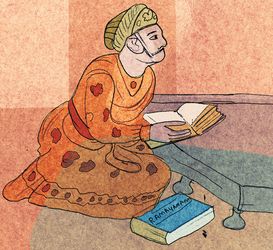The National Council of Educational Research and Training claims to have “balanced” the burden on 12th class school children by substantially reducing their learning and understanding of the Mughal legacy. In fact, they are only playing ‘Their Master’s Voice’ by carrying through the ideological obfuscation of the ruling saffron establishment. They claim to have given the vacated “space” to regional histories of Hindu dynasties but have, in fact, only added a few pages about the Vijayanagar Empire, leaving out any substantial additions to the Pallava, the Chola, the Pandya, the Chera, the Rashtrakuta, the Chalukya, the Sena, the Pala, the Ahom, and a host of others.
There was a reason the earlier texts gave more pages to the Mughals. These reasons were basically the same that covered the findings of the pre-Aryan Harappan heritage, the Vedic Age, the Buddha and Mahavira, the Asokan Empire, the Guptas and Adi Sankara, namely, that these were more nation-wide and had a longer cultural and civilisational impact on the nation’s memory of itself. But the Mughals have been downgraded precisely because their empire stretched all the way to the deep south and the east/north-east. The Mughal empire in the north extended to Kashmir and northwest to Pakistan, and even most of Afghanistan. This cannot be said of any of the regional kingdoms. I could, therefore, have understood a separate paper on our regional kingdoms, which are taught in colleges, but the pretence that the Mughals are given too much prominence is a political prejudice that should have no place in the formation of young minds.
Indeed, the cultural contribution of the Mughal period to our syncretic civilisation is far more significant than its political boundaries. For, it was during the rule of the Delhi Sultanate (1192-1526), predecessors to the Mughals (1526-1858), that the Hindawi language was developed (largely by Amir Khusrow in Delhi’s Nizamuddin Auliya) and has now become the Hindi of our times. It was also during the late Mughal period that Urdu arose and became one of the constitutionally recognised languages of independent India. Music and dance, painting, sculpture and poetry became at the time, under royal patronage, a precious national treasure rather than a sectional legacy. The architectural inheritance remains a proud part of our national pride. It was also during the Mughal period that the Ramayan and the Mahabharat, the Upanishads and the other masterpieces were translated into Persian for wider acquaintance to the non-Hindu minorities of India. It was a period of intense inter-religious interaction, for the Sufi and Bhakti movement, which underly almost all of contemporary Hindu belief and practice, unfolded during these centuries of Mughal rule in all their syncretic brilliance. Indeed, the origins of Bhakti movement may be dated from Saint Ramanuja who reigned spiritually from the Tamil country, synthesising the bitterly opposed Saivite and Vaishnavite traditions, when the Tughlaqs were on their thrones in far-away Delhi, but really flourished when Swami Ramanand, Tukaram, Chaitanya, Sankardev, Ravidas, Kabir and Mirabai spread their universal message of divine love under the benevolent gaze of the Delhi Sultanate and the Mughal emperors. It is indeed little recalled that Tulsidas wrote his Ramayan even as the Babri Masjid loomed over Ayodhya. And the apogee of the Bhakti movement under the ten Sikh Gurus came to final bloom when there were Muslim rulers on the Delhi throne.
While there might be merit in strengthening text book passages that highlight the civilisational consequences of Sultanate and Mughal rule, at the expense of political and military history, there is none in making little Jinnahs of our children by filling their minds with tendentious two-nation theories.
Aiyar is a former Union minister and social commentator.


